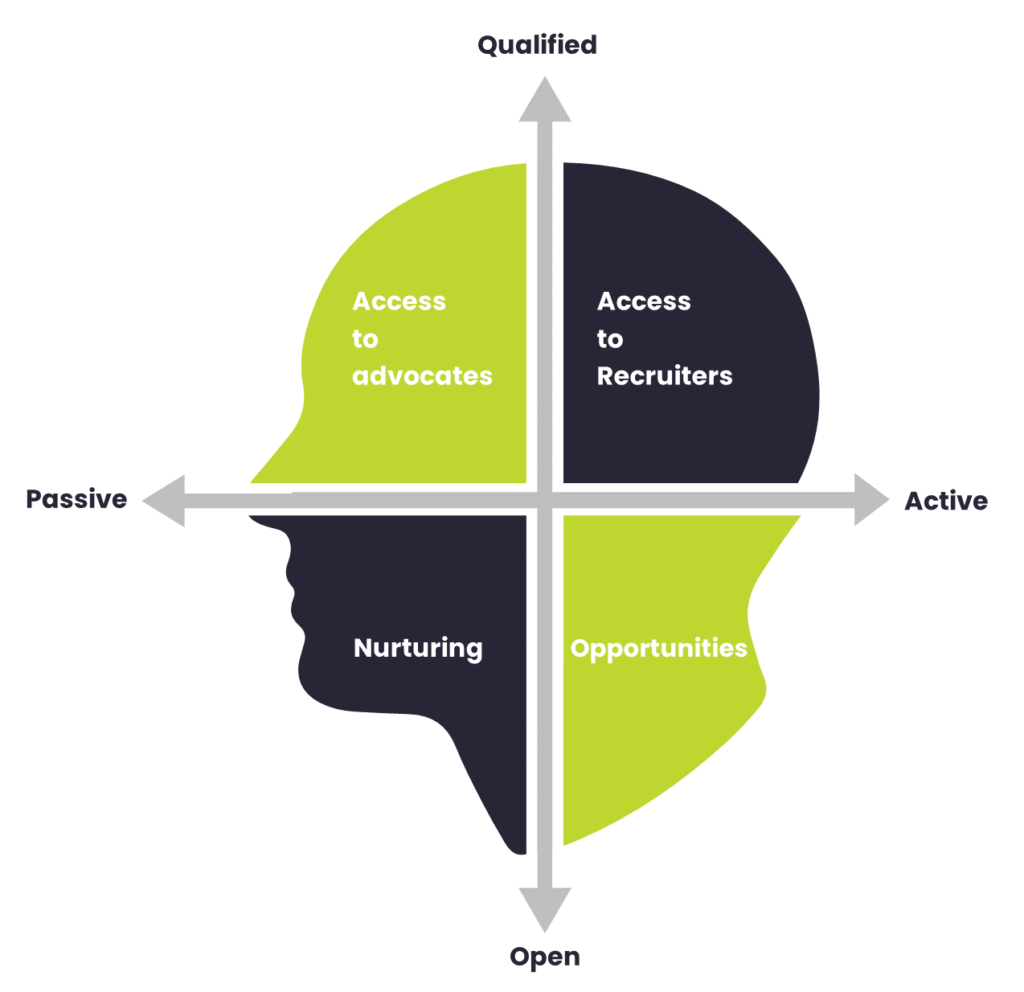Introduction
The candidate experience is not a static journey; it’s an ever-changing process that evolves based on both the candidate’s and the organisation’s needs. Given the fluid nature of job seeking and talent acquisition, how can we adapt our engagement strategies to better serve candidates at every stage? This blog aims to delve deeper into the concept of ‘adaptive engagement,’ a term that embodies the changing dynamics of candidate interaction.

The Shift from Passive to Active
Passive Candidates
At the passive stage, candidates might not actively be looking for a role but are open to opportunities. The focus here should be on nurturing these candidates and providing them with long-term knowledge-building material. What does your organisation have to offer that aligns with the candidate’s career aspirations or personal growth?
The key is to foster a sense of community while allowing candidates to explore the organisation without pressure. Providing business-related news, industry insights, or educational content can keep passive candidates engaged. How often do you interact with passive candidates, and what value are you delivering through those interactions?
Active Candidates
The scenario changes when a candidate shifts from passive to active engagement. Now, they are actively looking for roles and are ready to make a career move. The emphasis here shifts to understanding the candidate’s specific interests so that relevant content, especially job opportunities, can be delivered to them as quickly as possible.
What steps is your organisation taking to expedite this process? Do you have a system in place to immediately alert active candidates about relevant job openings?
Community Gating: Open Vs. Qualified Communities
Open Communities
Open communities are platforms where any individual can express an interest in your organisation. Here, you have the chance to provide an array of content that can capture the candidate’s initial interest. It’s open to all and serves as the first point of contact. It offers content, but not people; a way to dip one’s toes into what your organisation represents.
How are you ensuring that your open communities are both inviting and informative for the diverse interests of your candidates?
Qualified Communities
As candidates progress and their level of trust and engagement with the organisation increases, they may be shifted to more gated, or qualified, communities. These are spaces where candidates can interact more closely with specific roles within the organisation, be it business ambassadors, diversity advocates, or recruiters.
For passive candidates looking to know more about the culture and values, these qualified communities provide an excellent opportunity for deeper engagement. How are you leveraging these communities to provide a more tailored experience?
Importance of Adaptive Engagement in Talent Acquisition
So why does adaptive engagement matter? First, it respects the candidate’s position and needs at any given time. Whether they are passively researching or actively job-hunting, the engagement level adapts to suit them. Secondly, it provides a strategic advantage for the organisation in terms of talent pipelining. By keeping a candidate engaged at every stage of their journey, you build a sustainable talent pipeline that’s aligned with your organisation’s long-term goals.
What are you doing to ensure your talent acquisition strategies are adaptive?

Best Practices for Implementing Adaptive Engagement
- Data-Driven Approach: Use analytics to understand candidate behaviour and preferences. Tailor your engagement strategies based on real data.
- Personalisation: From the content shared to the frequency of interactions, ensure that your engagement is as personalised as possible.
- Transparency: Keep candidates updated on their status. If they’ve shifted from an open to a qualified community, let them know what that means for their engagement level with the organisation.
- Feedback Loop: Create mechanisms for candidates to provide feedback on their experience. It’s a two-way street, and their insights can help you refine your engagement strategies.
- Multi-Channel Engagement: Utilise various platforms—be it email, social media, or your organisation’s own community portal—to keep candidates engaged.
Conclusion
Adaptive engagement is not just a strategy but a philosophy that puts the candidate experience at the forefront of talent acquisition. It’s about building communities, fostering trust, and providing a dynamic environment where both the organisation and the candidate can evolve together. It’s time to ask yourself, is your organisation ready to adapt?
So, what steps will you take today to implement adaptive engagement in your organisation’s talent acquisition strategy?






